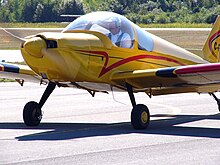Zenair CH 300
| Tri-Z CH 300 | |
|---|---|

| |
| Zenair CH 300 flown by "Red" Morris in the Canada Aviation and Space Museum | |
| Role | Homebuilt light aircraft |
| National origin | Canada |
| Manufacturer | Zenair |
| Designer | Chris Heintz |
| First flight | 9 July 1977 |
| Variants | AMD Alarus |
The Zenair Tri-Z CH 300 is a three-seat Canadian homebuilt light aircraft. A single-engined low-winged monoplane, the CH 300 first flew in 1977, with several hundred kits sold.
Development and design


The CH 300 is an enlarged three-seat derivative of the Zenair Zenith CH 200, designed by Chris Heintz in the mid 1970s as the Tri-Zénith.[1] Like the CH 200, it is a low-winged monoplane of all-metal construction with a fixed nosewheel undercarriage, but is larger and more powerful, and is fitted with a rear bench seat capable of accommodating a third adult or two children, and is fitted with a forward sliding canopy. It is designed to be powered by an engine giving between 125 and 180 hp (93 and 134 kW).[2][3]
The first example made its maiden flight on 9 July 1977, with over 400 sets of plans sold by 1982.[2] One CH 300, modified with extra fuel tanks and piloted by Robin "Red" Morris, made a non-stop trans-Canada flight between Vancouver International Airport and Halifax International Airport on 1–2 July 1978, covering the 2,759 mile (4,440 km) in 22 hours, 44 mins, setting three FAI Class C-1c point-to-point speed records.[2][3][4]
Plans for the CH 300 remained on sale in 1999.[5] The Zenair CH 300 formed the basis for the factory built Zenair CH-2000, which first flew in 1993.[5][6]
Variants
- CH 300
- Basic model with tricycle landing gear
- CH 300 TD
- "Taildragger" model with conventional landing gear
Aircraft on display
Specifications (150 hp O-320 engine)
Data from Jane's All The World's Aircraft 1982-83[2]
General characteristics
- Crew: 1
- Capacity: 2 passengers
- Length: 22 ft 6 in (6.85 m)
- Wingspan: 26 ft 7 in (8.10 m)
- Height: 6 ft 10 in (2.08 m)
- Wing area: 129.2 sq ft (12.00 m2)
- Aspect ratio: 5.48:1
- Empty weight: 1,100 lb (499 kg)
- Max takeoff weight: 1,850 lb (839 kg)
- Powerplant: 1 × Lycoming O-320 air-cooled flat-four, 150 hp (110 kW)
Performance
- Maximum speed: 160 mph (260 km/h, 140 kn)
- Cruise speed: 143 mph (230 km/h, 124 kn) (75% power)
- Stall speed: 53 mph (85 km/h, 46 kn) (flaps down)
- Range: 530 mi (850 km, 460 nmi)
- Rate of climb: 1,000 ft/min (5.1 m/s)
See also
Related development
Notes
- ^ Taylor 1976, p.458.
- ^ a b c d Taylor 1982, p.495.
- ^ a b Zenair, Zenair pamphlet, circa 1986.
- ^ "List of records established by the 'Zenair Tri-Z'[permanent dead link]". Fédération Aéronautique Internationale. Retrieved 27 February 2010.
- ^ a b Taylor 1999, p.535.
- ^ Taylor 1999, p.401.
- ^ Canada Aviation and Space Museum (n.d.). "Zenair CH-300 Tri-Z". Retrieved 9 June 2012.
References
- Taylor, John W. R. Jane's All The World's Aircraft 1976-77. London:Jane's Yearbooks, 1976. ISBN 0-354-00538-3.
- Taylor, John W. R. Jane's All The World's Aircraft 1982-83. London:Jane's Yearbooks, 1982. ISBN 0-7106-0748-2.
- Taylor, Michael J. H. Brassey's World Aircraft & Systems Directory 1999/2000. London:Brassey's, 1999. ISBN 1-85753-245-7.
